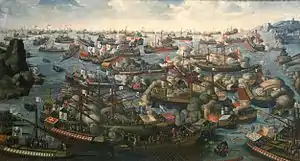Lepanto (poem)
"Lepanto" is a poem by G. K. Chesterton celebrating the victory of the Holy League in the Battle of Lepanto written in irregular stanzas of rhyming, roughly paeonic tetrameter couplets, often ending in a quatrain of four dimeter lines. The poem tells of the defeat of the Ottoman fleet of Ali Pasha by the Christian crusader, Don John of Austria. The poem was written in 1911 and published in Chesterton's 1915 collection Poems.

The poem's stirring verses helped inspire soldiers such as John Buchan during World War I.[1]
Context
"Lepanto" was published in 1915, and is in line with the author's other works of early decades of the century as representing a spirited rejection of the fin de siècle Decadent Fatalism which was the dominating philosophy in his youth.[2] As in the author's "The Ballad of the White Horse," the non-Christian forces are made representative of the determinist or fatalist philosophy that (in Chesterton's view) denied the value of human struggle and free will, and which he variously personified as pagan or Germanic (as in "The Ballad of the White Horse") or Mohammedan or Calvinist (as in this poem).[3] In "Lepanto," it is ironically Mahound himself, not Don John or Cervantes, who makes the clearest assessment of his Christian enemy's motivation and values: "It is he that saith not 'Kismet'; it is he that knows not Fate".
In World War I, the Turkish Ottoman Empire had become an ally of the Prussian enemy whom Chesterton saw as the perfect epitome of Paganism, Germanism, Imperialism, and Determinist Materialism. In this context, the victory of Christian Europe over its Turkish enemy depicted by Chesterton in vividly blood-stained terms became readily acceptable to those sympathetic to the British cause as a straightforward allegory of right — the Allied nations representing the traditional morality of Christendom — triumphing over wrong — the Central Powers representing the rejection of that morality in the name of the previously mentioned "-isms".[4] In the same context, the figure of Don John, "tiny and unafraid," was taken as representing England itself, a tiny nation standing against what then seemed to many Englishmen (and others) a vast hegemony of powerful, un-Christian states.
References
- Harry Blamires (1983), A Guide to Twentieth Century Literature in English, Taylor & Francis, p. 51, ISBN 9780416364507
- Vide the poet's description of the period in his Autobiography and his "Dedication to Edmund Clerihew Bentley" in The Man Who Was Thursday.
- The line "And Christian dreadeth Christ that hath a newer face of Doom" is the expression of Chesterton's conviction that the Calvinist belief in Predestination was a nominally Christian variation on the same (to him) horrifying idea of Determinism: note the word "Doom," which mirrors "Mahound's" use of "Kismet" and "Fate".
- Peter Faulkner (1995), "Introduction", The Works of G.K. Chesterton, Wordsworth Editions Ltd, p. vii, ISBN 1-85326-428-8
External links
| Wikisource has original text related to this article: |